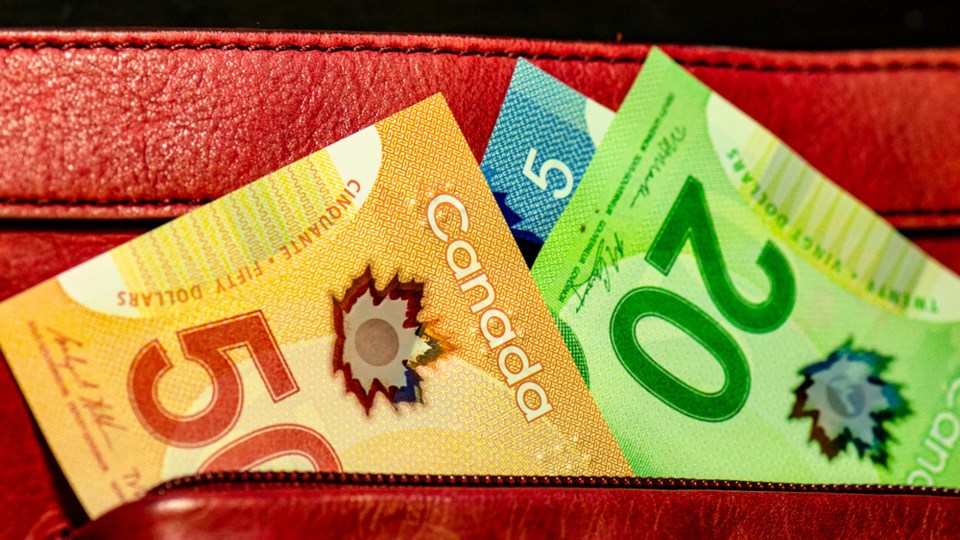For the past few weeks, Canadians have enjoyed an opportunity to go about their lives with no restrictions or mandates related to COVID-19.
We have previously measured the , and learned that 45 per cent of Canadians plan to continue to wear a mask every time they leave their home, even if they are no longer required to do so.
, a survey conducted by Research Co. and Glacier Media looked at just how much our purchasing behaviour had been affected by the pandemic. At the time, Canadians reported using cash for just three per cent of their purchases in the preceding month. This extremely low number was completely understandable. Residents were staying at home, “physically distancing” and reducing contact with other human beings to a minimum. Things like a tip for the pizza delivery person had to be arranged in advance, sometimes online.
Almost two years later, our behaviour has changed again. Late last month, when we re-asked the questions, Canadians told us that they relied on cash for 18 per cent of their recent transactions – a 15-point increase since the early weeks of the pandemic.
Almost half of our payments over the past 30 days (46 per cent) were made with a credit card or smartphone, while one-third (33 per cent) entailed a debit card or an e-transfer. Cheques, an option that may have afforded Canadians minimal physical contact with others in 2020, were only relied upon for three per cent of recent transactions.
There are some regional disparities when Canadians are asked how they pay for stuff. The credit card is heavily favoured by British Columbians (55 per cent) and Quebecers (50 per cent), while the debit card is the top choice for Ontarians (47 per cent) and Albertans (43 per cent).
Our ethnic origins may also pay a role in our preferred methods. More than seven in 10 payments made by Canadians of East Asian descent in the past month (72 per cent) were completed with a credit card, compared to 52 per cent for residents of Â鶹ÊÓƵ Asian descent, 45 per cent for Europeans and 33 per cent for those who identify as Indigenous. Conversely, cash is a more prevalent option for Indigenous Canadians (27 per cent) but drops dramatically among Europeans (17 per cent), Â鶹ÊÓƵ Asians (15 per cent) and East Asians (11 per cent).
Being away from an ATM can also complicate matters. More than three in five Canadians (63 per cent) admit that, over the course of the past month, there was a moment when they did not have any paper money with them and had to make a small purchase – less than $10 – with their credit or debit card.
Canadians aged 18 to 34 are more likely to report the experience of carrying a wallet devoid of small bills (77 per cent) than their counterparts aged 35 to 54 (64 per cent) and aged 55 and over (50 per cent).
For decades, science fiction films have speculated about the moment when humans will rely on biometrics, such as fingerprints, palm recognition or iris scans, to make purchases. Half of Canadians (50 per cent) believe they will be able to pay for things with biometrics at some point within the 10 years.
Residents of Alberta are the most likely to imagine a world where an iris scan or a fingerprint will replace a credit card (60 per cent). The proportions are lower in Ontario (52 per cent), British Columbia (50 per cent), Quebec (also 50 per cent), Saskatchewan and Manitoba (43 per cent) and Atlantic Canada (37 per cent).
In spite of this expectation, our own appetite for a world in which we no longer require cash or a signature is more nuanced. Just under two in five Canadians (39 per cent) say they would like to see people relying on biometrics to make purchases in their lifetime, while almost half (49 per cent) disagree.
Canadians aged 18 to 34, a generation that eschews passwords and places a smartphone in front of their face to gain access, are more likely to welcome iris scans for purchases (49 per cent) than their counterparts aged 35 to 54 (39 per cent) and aged 55 and over (30 per cent).
Once again, there are some significant variations on ethnicity. Canadians of European and East Asian descent are not keen on biometrics (32 per cent and 35 per cent respectively), along with Indigenous Canadians (42 per cent). However, the numbers climb to a staggering 78 per cent among Canadians of Â鶹ÊÓƵ Asian descent.
Almost two years have passed since our last look at the way we pay for things. The latest survey shows that, while most of our transactions continue to demand a credit or debit card, Canadians are more likely to use cash in 2022 than in 2020 – even if most of us sometimes forget to carry that elusive fiver. Finally, while we assume that biometrics will ultimately replace paper and plastic, not every Canadian is ready for that vision to become reality.
Mario Canseco is president of Research Co.
Results are based on an online study conducted from April 25 to April 27, 2022, among 1,000 adults in Canada. The data has been statistically weighted according to Canadian census figures for age, gender and region. The margin of error, which measures sample variability, is plus or minus 3.1 percentage points, 19 times out of 20.




